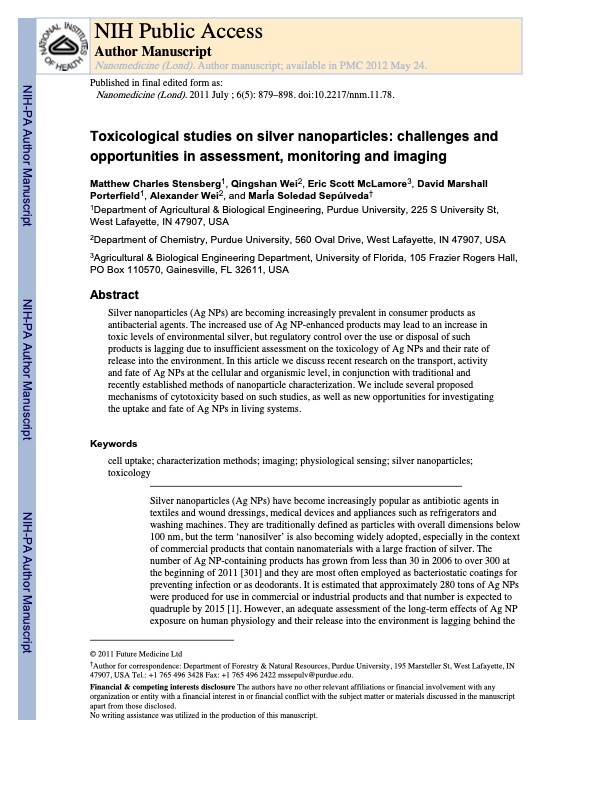
PDF Publication Title:
Text from PDF Page: 001
NIH Public Access Author Manuscript Nanomedicine (Lond). Author manuscript; available in PMC 2012 May 24. Published in final edited form as: Nanomedicine (Lond). 2011 July ; 6(5): 879–898. doi:10.2217/nnm.11.78. Toxicological studies on silver nanoparticles: challenges and opportunities in assessment, monitoring and imaging Matthew Charles Stensberg1, Qingshan Wei2, Eric Scott McLamore3, David Marshall Porterfield1, Alexander Wei2, and Marĺa Soledad Sepúlveda† 1Department of Agricultural & Biological Engineering, Purdue University, 225 S University St, West Lafayette, IN 47907, USA 2Department of Chemistry, Purdue University, 560 Oval Drive, West Lafayette, IN 47907, USA 3Agricultural & Biological Engineering Department, University of Florida, 105 Frazier Rogers Hall, PO Box 110570, Gainesville, FL 32611, USA Abstract Silver nanoparticles (Ag NPs) are becoming increasingly prevalent in consumer products as antibacterial agents. The increased use of Ag NP-enhanced products may lead to an increase in toxic levels of environmental silver, but regulatory control over the use or disposal of such products is lagging due to insufficient assessment on the toxicology of Ag NPs and their rate of release into the environment. In this article we discuss recent research on the transport, activity and fate of Ag NPs at the cellular and organismic level, in conjunction with traditional and recently established methods of nanoparticle characterization. We include several proposed mechanisms of cytotoxicity based on such studies, as well as new opportunities for investigating the uptake and fate of Ag NPs in living systems. Keywords cell uptake; characterization methods; imaging; physiological sensing; silver nanoparticles; toxicology Silver nanoparticles (Ag NPs) have become increasingly popular as antibiotic agents in textiles and wound dressings, medical devices and appliances such as refrigerators and washing machines. They are traditionally defined as particles with overall dimensions below 100 nm, but the term ‘nanosilver’ is also becoming widely adopted, especially in the context of commercial products that contain nanomaterials with a large fraction of silver. The number of Ag NP-containing products has grown from less than 30 in 2006 to over 300 at the beginning of 2011 [301] and they are most often employed as bacteriostatic coatings for preventing infection or as deodorants. It is estimated that approximately 280 tons of Ag NPs were produced for use in commercial or industrial products and that number is expected to quadruple by 2015 [1]. However, an adequate assessment of the long-term effects of Ag NP exposure on human physiology and their release into the environment is lagging behind the © 2011 Future Medicine Ltd †Author for correspondence: Department of Forestry & Natural Resources, Purdue University, 195 Marsteller St, West Lafayette, IN 47907, USA Tel.: +1 765 496 3428 Fax: +1 765 496 2422 mssepulv@purdue.edu. Financial & competing interests disclosure The authors have no other relevant affiliations or financial involvement with any organization or entity with a financial interest in or financial conflict with the subject matter or materials discussed in the manuscript apart from those disclosed. No writing assistance was utilized in the production of this manuscript. NIH-PA Author Manuscript NIH-PA Author Manuscript NIH-PA Author ManuscriptPDF Image | Toxicological studies on silver nanoparticles

PDF Search Title:
Toxicological studies on silver nanoparticlesOriginal File Name Searched:
nihms-316964.pdfDIY PDF Search: Google It | Yahoo | Bing
Turbine and System Plans CAD CAM: Special for this month, any plans are $10,000 for complete Cad/Cam blueprints. License is for one build. Try before you buy a production license. More Info
Waste Heat Power Technology: Organic Rankine Cycle uses waste heat to make electricity, shaft horsepower and cooling. More Info
All Turbine and System Products: Infinity Turbine ORD systems, turbine generator sets, build plans and more to use your waste heat from 30C to 100C. More Info
CO2 Phase Change Demonstrator: CO2 goes supercritical at 30 C. This is a experimental platform which you can use to demonstrate phase change with low heat. Includes integration area for small CO2 turbine, static generator, and more. This can also be used for a GTL Gas to Liquids experimental platform. More Info
Introducing the Infinity Turbine Products Infinity Turbine develops and builds systems for making power from waste heat. It also is working on innovative strategies for storing, making, and deploying energy. More Info
Need Strategy? Use our Consulting and analyst services Infinity Turbine LLC is pleased to announce its consulting and analyst services. We have worked in the renewable energy industry as a researcher, developing sales and markets, along with may inventions and innovations. More Info
Made in USA with Global Energy Millennial Web Engine These pages were made with the Global Energy Web PDF Engine using Filemaker (Claris) software.
Infinity Turbine Developing Spinning Disc Reactor SDR or Spinning Disc Reactors reduce processing time for liquid production of Silver Nanoparticles.
| CONTACT TEL: 608-238-6001 Email: greg@infinityturbine.com | RSS | AMP |